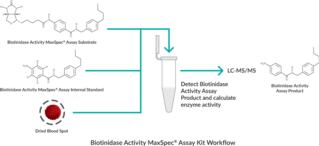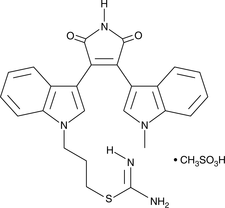Cayman
Showing 12001–12150 of 45550 results
-
N-Hydroxysuccinimide (NHS) activates carboxylic acid groups (on biotin) to facilitate coupling reactions. Biotin-X-NHS is a compound used to attach biotin to primary amines under alkaline conditions (pH~8-9). For example, lysines on the surface of proteins, including antibodies, are ideal targets for biotinylation with this compound. Biotin-X-NHS is like Biotin-NHS (Item No. 13315), but contains a six-atom spacer arm to minimize steric effects.
Brand:CaymanSKU:-N-Hydroxysuccinimide (NHS) activates carboxylic acid groups (on biotin) to facilitate coupling reactions. Biotin-X-NHS is a compound used to attach biotin to primary amines under alkaline conditions (pH~8-9). For example, lysines on the surface of proteins, including antibodies, are ideal targets for biotinylation with this compound. Biotin-X-NHS is like Biotin-NHS (Item No. 13315), but contains a six-atom spacer arm to minimize steric effects.
Brand:CaymanSKU:-N-Hydroxysuccinimide (NHS) activates carboxylic acid groups (on biotin) to facilitate coupling reactions. Biotin-X-NHS is a compound used to attach biotin to primary amines under alkaline conditions (pH~8-9). For example, lysines on the surface of proteins, including antibodies, are ideal targets for biotinylation with this compound. Biotin-X-NHS is like Biotin-NHS (Item No. 13315), but contains a six-atom spacer arm to minimize steric effects.
Brand:CaymanSKU:-Biotin-XX hydrazide is a biotylating reagent for carbohydrates and carbonyl compounds that contains two aminohexanoic spacers to increase the efficiency of avidin-binding by alleviating steric hindrance.{17906}
Brand:CaymanSKU:-Biotin-XX hydrazide is a biotylating reagent for carbohydrates and carbonyl compounds that contains two aminohexanoic spacers to increase the efficiency of avidin-binding by alleviating steric hindrance.{17906}
Brand:CaymanSKU:-Biotin-XX hydrazide is a biotylating reagent for carbohydrates and carbonyl compounds that contains two aminohexanoic spacers to increase the efficiency of avidin-binding by alleviating steric hindrance.{17906}
Brand:CaymanSKU:-Biotinidase is a peptidyl hydrolase that cleaves biocytin and biotinylated peptides in vivo to generate free biotin, an essential coenzyme for certain carboxylases involved in fatty acid, amino acid, and glucose metabolism.{32218,42936} Early-onset biotinidase deficiency is due to deletion, insertion, substitution, or missense mutations in the biotinidase gene, BTD, that affect the activity of multiple carboxylases. This profound biotinidase deficiency results in seizures, ataxia, sensorineural hearing loss or vision loss, eczema, and respiratory disruptions without treatment. Partial biotinidase deficiency is due to a substitution mutation in the BTD gene resulting in a 70-90% reduction in biotinidase activity leading to symptom manifestation that may not occur until adolescence and occurs only under biological stress. Many symptoms resolve with treatment, but retinal degeneration, sensorineural hearing loss, and developmental delays cannot be reversed. Early detection of biotinidase deficiency is imperative to avoid permanent damage.
Brand:CaymanSKU:27544 - 1 eaAvailable on backorder
Biotinyl tyramide is a reagent that has been used for tyramide signal amplification (TSA) via catalyzed reporter deposition (CARD).{45293} In CARD, a reporter enzyme, such as horseradish peroxidase (HRP) conjugated to a secondary antibody, is bound to the target of interest and catalyzes the covalent deposition of biotinyl tyramide to the sample. The sample is then probed by a detector, such as streptavidin-HRP, allowing detection via chromogenic or fluorescent methods. Biotinyl tyramide has been used in immunohistochemistry, ELISA, Western blot, and in situ hybridization applications.{45293,45294}
Brand:CaymanSKU:27997 - 10 mgAvailable on backorder
Biotinyl tyramide is a reagent that has been used for tyramide signal amplification (TSA) via catalyzed reporter deposition (CARD).{45293} In CARD, a reporter enzyme, such as horseradish peroxidase (HRP) conjugated to a secondary antibody, is bound to the target of interest and catalyzes the covalent deposition of biotinyl tyramide to the sample. The sample is then probed by a detector, such as streptavidin-HRP, allowing detection via chromogenic or fluorescent methods. Biotinyl tyramide has been used in immunohistochemistry, ELISA, Western blot, and in situ hybridization applications.{45293,45294}
Brand:CaymanSKU:27997 - 25 mgAvailable on backorder
Biotinyl tyramide is a reagent that has been used for tyramide signal amplification (TSA) via catalyzed reporter deposition (CARD).{45293} In CARD, a reporter enzyme, such as horseradish peroxidase (HRP) conjugated to a secondary antibody, is bound to the target of interest and catalyzes the covalent deposition of biotinyl tyramide to the sample. The sample is then probed by a detector, such as streptavidin-HRP, allowing detection via chromogenic or fluorescent methods. Biotinyl tyramide has been used in immunohistochemistry, ELISA, Western blot, and in situ hybridization applications.{45293,45294}
Brand:CaymanSKU:27997 - 50 mgAvailable on backorder
Apoptosis is induced by certain cytokines including TNF and Fas ligand in the TNF family through their death domain containing receptors. TNF-related apoptosis-inducing ligand (TRAIL or Apo2L), a member of this family, activates apoptosis in a variety of tumor cell lines by signaling through the death receptors, DR4 and DR5. Bioymifi directly activates DR5 (Kd = 1.2 µM; IC50 = 2 µM), inducing DR5 clustering, which leads to the initiation of FADD/caspase-8-dependent apoptosis in various cancer cells.{29884}
Brand:CaymanSKU:-Apoptosis is induced by certain cytokines including TNF and Fas ligand in the TNF family through their death domain containing receptors. TNF-related apoptosis-inducing ligand (TRAIL or Apo2L), a member of this family, activates apoptosis in a variety of tumor cell lines by signaling through the death receptors, DR4 and DR5. Bioymifi directly activates DR5 (Kd = 1.2 µM; IC50 = 2 µM), inducing DR5 clustering, which leads to the initiation of FADD/caspase-8-dependent apoptosis in various cancer cells.{29884}
Brand:CaymanSKU:-Apoptosis is induced by certain cytokines including TNF and Fas ligand in the TNF family through their death domain containing receptors. TNF-related apoptosis-inducing ligand (TRAIL or Apo2L), a member of this family, activates apoptosis in a variety of tumor cell lines by signaling through the death receptors, DR4 and DR5. Bioymifi directly activates DR5 (Kd = 1.2 µM; IC50 = 2 µM), inducing DR5 clustering, which leads to the initiation of FADD/caspase-8-dependent apoptosis in various cancer cells.{29884}
Brand:CaymanSKU:-Apoptosis is induced by certain cytokines including TNF and Fas ligand in the TNF family through their death domain containing receptors. TNF-related apoptosis-inducing ligand (TRAIL or Apo2L), a member of this family, activates apoptosis in a variety of tumor cell lines by signaling through the death receptors, DR4 and DR5. Bioymifi directly activates DR5 (Kd = 1.2 µM; IC50 = 2 µM), inducing DR5 clustering, which leads to the initiation of FADD/caspase-8-dependent apoptosis in various cancer cells.{29884}
Brand:CaymanSKU:-Biperiden is a muscarinic acetylcholine receptor antagonist of (Kis = 0.48, 6.3, 3.9, 2.4, and 6.3 nM for M1-5 receptors, respectively, in CHO-K1 cells expressing cloned receptors).{22786} It inhibits binding of [3H]quinuclidinyl benzilate (QNB) to muscarinic receptors in tissue homogenates (IC50s = 79, 52, and 38 nM for rat heart, rat lung, and guinea pig lung, respectively) and in vivo (IC50s = 2.5, 1.1, and 1.2 mg/kg for mouse cerebral cortex, cerebellum, and heart, respectively).{39393,39394} Biperiden (1 μM) increases spontaneous and electrically-evoked dopamine (DA) and electrically-evoked acetylcholine (ACh) release from rabbit caudate nucleus slices preincubated with dopamine in vitro.{39395} It is also an uncompetitive NMDA receptor antagonist and inhibits NMDA-evoked ACh release at a concentration of 10 μM.{39396} Biperiden (0.01-1.0 mg/kg) reduces physostigmine-induced tremor in rats in a dose-dependent manner.{39397} Formulations containing biperiden have been used as an adjuvant treatment for Parkinson’s disease.
Brand:CaymanSKU:23775 - 10 mgAvailable on backorder
Biperiden is a muscarinic acetylcholine receptor antagonist of (Kis = 0.48, 6.3, 3.9, 2.4, and 6.3 nM for M1-5 receptors, respectively, in CHO-K1 cells expressing cloned receptors).{22786} It inhibits binding of [3H]quinuclidinyl benzilate (QNB) to muscarinic receptors in tissue homogenates (IC50s = 79, 52, and 38 nM for rat heart, rat lung, and guinea pig lung, respectively) and in vivo (IC50s = 2.5, 1.1, and 1.2 mg/kg for mouse cerebral cortex, cerebellum, and heart, respectively).{39393,39394} Biperiden (1 μM) increases spontaneous and electrically-evoked dopamine (DA) and electrically-evoked acetylcholine (ACh) release from rabbit caudate nucleus slices preincubated with dopamine in vitro.{39395} It is also an uncompetitive NMDA receptor antagonist and inhibits NMDA-evoked ACh release at a concentration of 10 μM.{39396} Biperiden (0.01-1.0 mg/kg) reduces physostigmine-induced tremor in rats in a dose-dependent manner.{39397} Formulations containing biperiden have been used as an adjuvant treatment for Parkinson’s disease.
Brand:CaymanSKU:23775 - 25 mgAvailable on backorder
Biperiden is a muscarinic acetylcholine receptor antagonist of (Kis = 0.48, 6.3, 3.9, 2.4, and 6.3 nM for M1-5 receptors, respectively, in CHO-K1 cells expressing cloned receptors).{22786} It inhibits binding of [3H]quinuclidinyl benzilate (QNB) to muscarinic receptors in tissue homogenates (IC50s = 79, 52, and 38 nM for rat heart, rat lung, and guinea pig lung, respectively) and in vivo (IC50s = 2.5, 1.1, and 1.2 mg/kg for mouse cerebral cortex, cerebellum, and heart, respectively).{39393,39394} Biperiden (1 μM) increases spontaneous and electrically-evoked dopamine (DA) and electrically-evoked acetylcholine (ACh) release from rabbit caudate nucleus slices preincubated with dopamine in vitro.{39395} It is also an uncompetitive NMDA receptor antagonist and inhibits NMDA-evoked ACh release at a concentration of 10 μM.{39396} Biperiden (0.01-1.0 mg/kg) reduces physostigmine-induced tremor in rats in a dose-dependent manner.{39397} Formulations containing biperiden have been used as an adjuvant treatment for Parkinson’s disease.
Brand:CaymanSKU:23775 - 5 mgAvailable on backorder
Biperiden is a muscarinic acetylcholine receptor antagonist of (Kis = 0.48, 6.3, 3.9, 2.4, and 6.3 nM for M1-5 receptors, respectively, in CHO-K1 cells expressing cloned receptors).{22786} It inhibits binding of [3H]quinuclidinyl benzilate (QNB) to muscarinic receptors in tissue homogenates (IC50s = 79, 52, and 38 nM for rat heart, rat lung, and guinea pig lung, respectively) and in vivo (IC50s = 2.5, 1.1, and 1.2 mg/kg for mouse cerebral cortex, cerebellum, and heart, respectively).{39393,39394} Biperiden (1 μM) increases spontaneous and electrically-evoked dopamine (DA) and electrically-evoked acetylcholine (ACh) release from rabbit caudate nucleus slices preincubated with dopamine in vitro.{39395} It is also an uncompetitive NMDA receptor antagonist and inhibits NMDA-evoked ACh release at a concentration of 10 μM.{39396} Biperiden (0.01-1.0 mg/kg) reduces physostigmine-induced tremor in rats in a dose-dependent manner.{39397} Formulations containing biperiden have been used as an adjuvant treatment for Parkinson’s disease.
Brand:CaymanSKU:23775 - 50 mgAvailable on backorder
Brand:CaymanSKU:11054 - 1 gAvailable on backorder
Brand:CaymanSKU:11054 - 5 gAvailable on backorder
Brand:CaymanSKU:11054 - 500 mgAvailable on backorder
The metabotropic glutamate receptor 2 (mGluR2) is a Gi/o-coupled receptor which is expressed on presynaptic nerve terminals and modulates the release of neurotransmitters like glutamate and GABA.{21987} Biphenylindanone A (BINA) is a positive allosteric modulator of mGluR2, stimulating the human and rat receptors with EC50 values of 33.2 and 96 nM, respectively.{21984} It has no effect on glutamate-induced activation of other mGluR types.{21984} BINA can be used on cells, tissues, or animals.{21984,21983} Because of its selectivity for mGluR2, robust in vivo activity, and brain penetrance, BINA can be used to elucidate the role of mGluR2 in such diverse processes as psychosis, schizophrenia, and drug addiction.{21982,21985,21986}
Brand:CaymanSKU:11986 - 10 mgAvailable on backorder
The metabotropic glutamate receptor 2 (mGluR2) is a Gi/o-coupled receptor which is expressed on presynaptic nerve terminals and modulates the release of neurotransmitters like glutamate and GABA.{21987} Biphenylindanone A (BINA) is a positive allosteric modulator of mGluR2, stimulating the human and rat receptors with EC50 values of 33.2 and 96 nM, respectively.{21984} It has no effect on glutamate-induced activation of other mGluR types.{21984} BINA can be used on cells, tissues, or animals.{21984,21983} Because of its selectivity for mGluR2, robust in vivo activity, and brain penetrance, BINA can be used to elucidate the role of mGluR2 in such diverse processes as psychosis, schizophrenia, and drug addiction.{21982,21985,21986}
Brand:CaymanSKU:11986 - 25 mgAvailable on backorder
The metabotropic glutamate receptor 2 (mGluR2) is a Gi/o-coupled receptor which is expressed on presynaptic nerve terminals and modulates the release of neurotransmitters like glutamate and GABA.{21987} Biphenylindanone A (BINA) is a positive allosteric modulator of mGluR2, stimulating the human and rat receptors with EC50 values of 33.2 and 96 nM, respectively.{21984} It has no effect on glutamate-induced activation of other mGluR types.{21984} BINA can be used on cells, tissues, or animals.{21984,21983} Because of its selectivity for mGluR2, robust in vivo activity, and brain penetrance, BINA can be used to elucidate the role of mGluR2 in such diverse processes as psychosis, schizophrenia, and drug addiction.{21982,21985,21986}
Brand:CaymanSKU:11986 - 5 mgAvailable on backorder
Birinapant is a bivalent mimetic of the Diablo homolog known as second mitochondria-derived activator of caspase (Smac). It is an antagonist of cellular inhibitor of apoptosis 1 (cIAP1, or BIRC2), cIAP2 (BIRC3), and XIAP (BIRC4), binding each at nanomolar concentrations.{34146} Birinapant causes rapid cIAP1 degradation, caspase activation, PARP cleavage, and NF-κB activation in breast cancer cells.{34146} It shows in vivo antitumor activity, inducing apoptosis in several types of cancer xenografts in mice.{34147,34148}
Brand:CaymanSKU:19699 -Available on backorder
Birinapant is a bivalent mimetic of the Diablo homolog known as second mitochondria-derived activator of caspase (Smac). It is an antagonist of cellular inhibitor of apoptosis 1 (cIAP1, or BIRC2), cIAP2 (BIRC3), and XIAP (BIRC4), binding each at nanomolar concentrations.{34146} Birinapant causes rapid cIAP1 degradation, caspase activation, PARP cleavage, and NF-κB activation in breast cancer cells.{34146} It shows in vivo antitumor activity, inducing apoptosis in several types of cancer xenografts in mice.{34147,34148}
Brand:CaymanSKU:19699 -Available on backorder
Birinapant is a bivalent mimetic of the Diablo homolog known as second mitochondria-derived activator of caspase (Smac). It is an antagonist of cellular inhibitor of apoptosis 1 (cIAP1, or BIRC2), cIAP2 (BIRC3), and XIAP (BIRC4), binding each at nanomolar concentrations.{34146} Birinapant causes rapid cIAP1 degradation, caspase activation, PARP cleavage, and NF-κB activation in breast cancer cells.{34146} It shows in vivo antitumor activity, inducing apoptosis in several types of cancer xenografts in mice.{34147,34148}
Brand:CaymanSKU:19699 -Available on backorder
Birinapant is a bivalent mimetic of the Diablo homolog known as second mitochondria-derived activator of caspase (Smac). It is an antagonist of cellular inhibitor of apoptosis 1 (cIAP1, or BIRC2), cIAP2 (BIRC3), and XIAP (BIRC4), binding each at nanomolar concentrations.{34146} Birinapant causes rapid cIAP1 degradation, caspase activation, PARP cleavage, and NF-κB activation in breast cancer cells.{34146} It shows in vivo antitumor activity, inducing apoptosis in several types of cancer xenografts in mice.{34147,34148}
Brand:CaymanSKU:19699 -Available on backorder
Bis-(2-chloroisopropyl) ether is a byproduct in the synthesis of ethylene and propylene glycol that has been found in municipal drinking water in the United States and waterways in the Netherlands where it is considered a persistent organic pollutant (POP).{42284} It is mutagenic in the S. typhimurium strains TA 1535 and TA 100 but lacks mutagenic activity in mice.
Brand:CaymanSKU:20683 -Available on backorder
Bis-(2-chloroisopropyl) ether is a byproduct in the synthesis of ethylene and propylene glycol that has been found in municipal drinking water in the United States and waterways in the Netherlands where it is considered a persistent organic pollutant (POP).{42284} It is mutagenic in the S. typhimurium strains TA 1535 and TA 100 but lacks mutagenic activity in mice.
Brand:CaymanSKU:20683 -Available on backorder
Bis-(2-chloroisopropyl) ether is a byproduct in the synthesis of ethylene and propylene glycol that has been found in municipal drinking water in the United States and waterways in the Netherlands where it is considered a persistent organic pollutant (POP).{42284} It is mutagenic in the S. typhimurium strains TA 1535 and TA 100 but lacks mutagenic activity in mice.
Brand:CaymanSKU:20683 -Available on backorder
Bis-(2-chloroisopropyl) ether is a byproduct in the synthesis of ethylene and propylene glycol that has been found in municipal drinking water in the United States and waterways in the Netherlands where it is considered a persistent organic pollutant (POP).{42284} It is mutagenic in the S. typhimurium strains TA 1535 and TA 100 but lacks mutagenic activity in mice.
Brand:CaymanSKU:20683 -Available on backorder
bis-ANS is a high-affinity non-covalent extrinsic fluorescent dye used to analyze protein conformation.{33937} Its predominant interaction with proteins is through its hydrophobic phenyl and naphthyl rings.{33952} bis-ANS has an excitation maxima of 390 nm.{14908} It has an emission maximum of 523 nm when free in solution but undergoes a blue shift with an increase in fluorescence intensity when bound to protein; for example, when bound to intestinal fatty acid binding protein (FAPB2) it has emission maxima of 484-496 nm. bis-ANS has been used to label mechanically damaged neurons in acute brain slices.{33940} It also potently inhibits microtubule assembly.{33938,33939}
Brand:CaymanSKU:21820 -Out of stock
bis-ANS is a high-affinity non-covalent extrinsic fluorescent dye used to analyze protein conformation.{33937} Its predominant interaction with proteins is through its hydrophobic phenyl and naphthyl rings.{33952} bis-ANS has an excitation maxima of 390 nm.{14908} It has an emission maximum of 523 nm when free in solution but undergoes a blue shift with an increase in fluorescence intensity when bound to protein; for example, when bound to intestinal fatty acid binding protein (FAPB2) it has emission maxima of 484-496 nm. bis-ANS has been used to label mechanically damaged neurons in acute brain slices.{33940} It also potently inhibits microtubule assembly.{33938,33939}
Brand:CaymanSKU:21820 -Out of stock
bis-ANS is a high-affinity non-covalent extrinsic fluorescent dye used to analyze protein conformation.{33937} Its predominant interaction with proteins is through its hydrophobic phenyl and naphthyl rings.{33952} bis-ANS has an excitation maxima of 390 nm.{14908} It has an emission maximum of 523 nm when free in solution but undergoes a blue shift with an increase in fluorescence intensity when bound to protein; for example, when bound to intestinal fatty acid binding protein (FAPB2) it has emission maxima of 484-496 nm. bis-ANS has been used to label mechanically damaged neurons in acute brain slices.{33940} It also potently inhibits microtubule assembly.{33938,33939}
Brand:CaymanSKU:21820 -Out of stock
Tacrine is an amino acridine compound that inhibits acetylcholinesterase (AChE), and has been proposed as a clinical treatment for Alzheimer’s disease.{6603} bis(7)-Tacrine is a tacrine dimer, linked via a 7-carbon alkyl spacer. It inhibits AChE with an IC50 of 0.40 nM, making it more than 1,000 times more potent than tacrine.{12097} bis(7)-Tacrine also protects against hydrogen peroxide induced apoptosis in rat pheochromocytoma cells.{12095}
Brand:CaymanSKU:10005836 - 10 mgAvailable on backorder
Tacrine is an amino acridine compound that inhibits acetylcholinesterase (AChE), and has been proposed as a clinical treatment for Alzheimer’s disease.{6603} bis(7)-Tacrine is a tacrine dimer, linked via a 7-carbon alkyl spacer. It inhibits AChE with an IC50 of 0.40 nM, making it more than 1,000 times more potent than tacrine.{12097} bis(7)-Tacrine also protects against hydrogen peroxide induced apoptosis in rat pheochromocytoma cells.{12095}
Brand:CaymanSKU:10005836 - 100 mgAvailable on backorder
Tacrine is an amino acridine compound that inhibits acetylcholinesterase (AChE), and has been proposed as a clinical treatment for Alzheimer’s disease.{6603} bis(7)-Tacrine is a tacrine dimer, linked via a 7-carbon alkyl spacer. It inhibits AChE with an IC50 of 0.40 nM, making it more than 1,000 times more potent than tacrine.{12097} bis(7)-Tacrine also protects against hydrogen peroxide induced apoptosis in rat pheochromocytoma cells.{12095}
Brand:CaymanSKU:10005836 - 5 mgAvailable on backorder
Tacrine is an amino acridine compound that inhibits acetylcholinesterase (AChE), and has been proposed as a clinical treatment for Alzheimer’s disease.{6603} bis(7)-Tacrine is a tacrine dimer, linked via a 7-carbon alkyl spacer. It inhibits AChE with an IC50 of 0.40 nM, making it more than 1,000 times more potent than tacrine.{12097} bis(7)-Tacrine also protects against hydrogen peroxide induced apoptosis in rat pheochromocytoma cells.{12095}
Brand:CaymanSKU:10005836 - 50 mgAvailable on backorder
Bis(methylthio)gliotoxin is a fungal metabolite originally isolated from G. deliquescens that has diverse biological activities.{36971} It inhibits PAF- and collagen-induced platelet aggregation in rabbit platelet-rich plasma (IC50s = 8.4 and 84.2 µM, respectively) but has no effect on arachidonic acid- or ADP-induced platelet aggregation (IC50s = >400 µM).{36972} Bis(methylthio)gliotoxin inhibits growth of HCT116 colon cancer cells (IC50 = 23.56 µM).{36973} It inhibits PAF-induced bronchoconstriction in guinea pigs when administered at a dose of 0.1 mg/kg and is less toxic to mice (LD50 = >500 mg/kg) than gliotoxin (Item No. 11433).{36972,36974} Bis(methylthio)gliotoxin has been used as a serum biomarker in patients infected with invasive aspergillosis.{36975}
Brand:CaymanSKU:26271 - 1 mgAvailable on backorder
Bis(methylthio)gliotoxin is a fungal metabolite originally isolated from G. deliquescens that has diverse biological activities.{36971} It inhibits PAF- and collagen-induced platelet aggregation in rabbit platelet-rich plasma (IC50s = 8.4 and 84.2 µM, respectively) but has no effect on arachidonic acid- or ADP-induced platelet aggregation (IC50s = >400 µM).{36972} Bis(methylthio)gliotoxin inhibits growth of HCT116 colon cancer cells (IC50 = 23.56 µM).{36973} It inhibits PAF-induced bronchoconstriction in guinea pigs when administered at a dose of 0.1 mg/kg and is less toxic to mice (LD50 = >500 mg/kg) than gliotoxin (Item No. 11433).{36972,36974} Bis(methylthio)gliotoxin has been used as a serum biomarker in patients infected with invasive aspergillosis.{36975}
Brand:CaymanSKU:26271 - 500 µgAvailable on backorder
Bisacodyl is a prodrug form of the stimulant laxative desacetyl bisacodyl (Item No. 20928).{33529} It reduces the activity of Na+/K+-ATPases in isolated rat colon following administration in the drinking water at a concentration of 83 µM.{48734} Bisacodyl (20 mg/kg) decreases colonic aquaporin-3 levels and increases stool water content in rats, effects that are reversed by the COX inhibitor indomethacin (Item No. 70270).{33527} Formulations containing bisacodyl have been used in the treatment of constipation.
Brand:CaymanSKU:28826 - 10 gAvailable on backorder
Bisacodyl is a prodrug form of the stimulant laxative desacetyl bisacodyl (Item No. 20928).{33529} It reduces the activity of Na+/K+-ATPases in isolated rat colon following administration in the drinking water at a concentration of 83 µM.{48734} Bisacodyl (20 mg/kg) decreases colonic aquaporin-3 levels and increases stool water content in rats, effects that are reversed by the COX inhibitor indomethacin (Item No. 70270).{33527} Formulations containing bisacodyl have been used in the treatment of constipation.
Brand:CaymanSKU:28826 - 100 gAvailable on backorder
Bisacodyl is a prodrug form of the stimulant laxative desacetyl bisacodyl (Item No. 20928).{33529} It reduces the activity of Na+/K+-ATPases in isolated rat colon following administration in the drinking water at a concentration of 83 µM.{48734} Bisacodyl (20 mg/kg) decreases colonic aquaporin-3 levels and increases stool water content in rats, effects that are reversed by the COX inhibitor indomethacin (Item No. 70270).{33527} Formulations containing bisacodyl have been used in the treatment of constipation.
Brand:CaymanSKU:28826 - 25 gAvailable on backorder
Bisacodyl is a prodrug form of the stimulant laxative desacetyl bisacodyl (Item No. 20928).{33529} It reduces the activity of Na+/K+-ATPases in isolated rat colon following administration in the drinking water at a concentration of 83 µM.{48734} Bisacodyl (20 mg/kg) decreases colonic aquaporin-3 levels and increases stool water content in rats, effects that are reversed by the COX inhibitor indomethacin (Item No. 70270).{33527} Formulations containing bisacodyl have been used in the treatment of constipation.
Brand:CaymanSKU:28826 - 50 gAvailable on backorder
Bacterial type II fatty acid synthesis (FAS-II) is mediated by a series of enzymes, each of which may be targeted by potential antibiotics.{31077} Bischloroanthrabenzoxocinone (BABX) is an inhibitor of FAS-II, blocking fatty acid synthesis in S. aureus and E. coli with IC50 values of 11.4 and 35.3 µg/ml, respectively.{31076} It inhibits the growth of S. aureus and permeable E. coli strains with minimum inhibitory concentrations ranging from 0.2-0.4 µg/ml.{31076,31075} BABX also displays binding to liver X receptors (LXRs), inhibiting agonist binding in an LXRα-scintillation proximity assay (IC50 = 10 µM).{31075}
Brand:CaymanSKU:-Available on backorder
Bacterial type II fatty acid synthesis (FAS-II) is mediated by a series of enzymes, each of which may be targeted by potential antibiotics.{31077} Bischloroanthrabenzoxocinone (BABX) is an inhibitor of FAS-II, blocking fatty acid synthesis in S. aureus and E. coli with IC50 values of 11.4 and 35.3 µg/ml, respectively.{31076} It inhibits the growth of S. aureus and permeable E. coli strains with minimum inhibitory concentrations ranging from 0.2-0.4 µg/ml.{31076,31075} BABX also displays binding to liver X receptors (LXRs), inhibiting agonist binding in an LXRα-scintillation proximity assay (IC50 = 10 µM).{31075}
Brand:CaymanSKU:-Available on backorder
Bisdemethoxycurcumin (BDMC) is a natural demethoxy derivative of curcumin. It is a potent activator of macrophage phagocytosis, interacting with 1α,25-dihydroxy vitamin D3 to stimulate amyloid-β clearance by macrophages (optimal stimulation at 100 nM BDMC).{19781,19788,19791} More stable than curcumin in physiological media, BDMC suppresses proliferation in cancer cells.{19787,19792} It down-regulates the transcriptional coactivator p300, suppressing the Wnt/β-catenin pathway, and inhibits LPS induction of iNOS expression.{19784,19789}
Brand:CaymanSKU:10960 - 10 mgAvailable on backorder
Bisdemethoxycurcumin (BDMC) is a natural demethoxy derivative of curcumin. It is a potent activator of macrophage phagocytosis, interacting with 1α,25-dihydroxy vitamin D3 to stimulate amyloid-β clearance by macrophages (optimal stimulation at 100 nM BDMC).{19781,19788,19791} More stable than curcumin in physiological media, BDMC suppresses proliferation in cancer cells.{19787,19792} It down-regulates the transcriptional coactivator p300, suppressing the Wnt/β-catenin pathway, and inhibits LPS induction of iNOS expression.{19784,19789}
Brand:CaymanSKU:10960 - 25 mgAvailable on backorder
Bisdemethoxycurcumin (BDMC) is a natural demethoxy derivative of curcumin. It is a potent activator of macrophage phagocytosis, interacting with 1α,25-dihydroxy vitamin D3 to stimulate amyloid-β clearance by macrophages (optimal stimulation at 100 nM BDMC).{19781,19788,19791} More stable than curcumin in physiological media, BDMC suppresses proliferation in cancer cells.{19787,19792} It down-regulates the transcriptional coactivator p300, suppressing the Wnt/β-catenin pathway, and inhibits LPS induction of iNOS expression.{19784,19789}
Brand:CaymanSKU:10960 - 5 mgAvailable on backorder
Bisdemethoxycurcumin (BDMC) is a natural demethoxy derivative of curcumin. It is a potent activator of macrophage phagocytosis, interacting with 1α,25-dihydroxy vitamin D3 to stimulate amyloid-β clearance by macrophages (optimal stimulation at 100 nM BDMC).{19781,19788,19791} More stable than curcumin in physiological media, BDMC suppresses proliferation in cancer cells.{19787,19792} It down-regulates the transcriptional coactivator p300, suppressing the Wnt/β-catenin pathway, and inhibits LPS induction of iNOS expression.{19784,19789}
Brand:CaymanSKU:10960 - 50 mgAvailable on backorder
Bisindolylmaleimide I (BIM I) is a highly selective, cell-permeable, and reversible PKC inhibitor (Ki = 14 nM) that is structurally similar to the poorly selective PKC inhibitor staurosporine (Item No. 81590).{17275} It acts as a competitive inhibitor for the ATP binding site of PKC and shows high selectivity for PKCα, β1, β2, γ, δ, and ε isozymes. BIM I directly inhibits glycogen synthase kinase 3 (GSK3) in primary adipocyte lysates (IC50 = 360 nM) and in GSK3β immunoprecipitates derived from rat epididymal adipocytes (IC50 = 170 nM).{17379} It also competitively antagonizes the serotonin (5-HT) receptor subtype 5-HT3 with a Ki value of 61 nM.{17380}
Brand:CaymanSKU:-Bisindolylmaleimide I (BIM I) is a highly selective, cell-permeable, and reversible PKC inhibitor (Ki = 14 nM) that is structurally similar to the poorly selective PKC inhibitor staurosporine (Item No. 81590).{17275} It acts as a competitive inhibitor for the ATP binding site of PKC and shows high selectivity for PKCα, β1, β2, γ, δ, and ε isozymes. BIM I directly inhibits glycogen synthase kinase 3 (GSK3) in primary adipocyte lysates (IC50 = 360 nM) and in GSK3β immunoprecipitates derived from rat epididymal adipocytes (IC50 = 170 nM).{17379} It also competitively antagonizes the serotonin (5-HT) receptor subtype 5-HT3 with a Ki value of 61 nM.{17380}
Brand:CaymanSKU:-Bisindolylmaleimide I (BIM I) is a highly selective, cell-permeable, and reversible PKC inhibitor (Ki = 14 nM) that is structurally similar to the poorly selective PKC inhibitor staurosporine (Item No. 81590).{17275} It acts as a competitive inhibitor for the ATP binding site of PKC and shows high selectivity for PKCα, β1, β2, γ, δ, and ε isozymes. BIM I directly inhibits glycogen synthase kinase 3 (GSK3) in primary adipocyte lysates (IC50 = 360 nM) and in GSK3β immunoprecipitates derived from rat epididymal adipocytes (IC50 = 170 nM).{17379} It also competitively antagonizes the serotonin (5-HT) receptor subtype 5-HT3 with a Ki value of 61 nM.{17380}
Brand:CaymanSKU:-Bisindolylmaleimide I (BIM I) is a highly selective, cell-permeable, and reversible PKC inhibitor (Ki = 14 nM) that is structurally similar to the poorly selective PKC inhibitor staurosporine (Item No. 81590).{17275} It acts as a competitive inhibitor for the ATP binding site of PKC and shows high selectivity for PKCα, β1, β2, γ, δ, and ε isozymes. BIM I directly inhibits glycogen synthase kinase 3 (GSK3) in primary adipocyte lysates (IC50 = 360 nM) and in GSK3β immunoprecipitates derived from rat epididymal adipocytes (IC50 = 170 nM).{17379} It also competitively antagonizes the serotonin (5-HT) receptor subtype 5-HT3 with a Ki value of 61 nM.{17380}
Brand:CaymanSKU:-Bisindolylmaleimide I (BIM I) is a highly selective, cell-permeable, and reversible PKC inhibitor (Ki = 14 nM) that is structurally similar to the poorly selective PKC inhibitor staurosporine (Item No. 81590).{17275} It acts as a competitive inhibitor for the ATP binding site of PKC and shows high selectivity for PKCα, β1, β2, γ, δ, and ε isozymes. BIM I directly inhibits glycogen synthase kinase 3 (GSK3) in primary adipocyte lysates (IC50 = 360 nM) and in GSK3β immunoprecipitates derived from rat epididymal adipocytes (IC50 = 170 nM).{17379} It also competitively antagonizes the serotonin (5-HT) receptor subtype 5-HT3 with a Ki value of 61 nM.{17380}
Brand:CaymanSKU:21180 -Out of stock
Bisindolylmaleimide I (BIM I) is a highly selective, cell-permeable, and reversible PKC inhibitor (Ki = 14 nM) that is structurally similar to the poorly selective PKC inhibitor staurosporine (Item No. 81590).{17275} It acts as a competitive inhibitor for the ATP binding site of PKC and shows high selectivity for PKCα, β1, β2, γ, δ, and ε isozymes. BIM I directly inhibits glycogen synthase kinase 3 (GSK3) in primary adipocyte lysates (IC50 = 360 nM) and in GSK3β immunoprecipitates derived from rat epididymal adipocytes (IC50 = 170 nM).{17379} It also competitively antagonizes the serotonin (5-HT) receptor subtype 5-HT3 with a Ki value of 61 nM.{17380}
Brand:CaymanSKU:21180 -Out of stock
Bisindolylmaleimide I (BIM I) is a highly selective, cell-permeable, and reversible PKC inhibitor (Ki = 14 nM) that is structurally similar to the poorly selective PKC inhibitor staurosporine (Item No. 81590).{17275} It acts as a competitive inhibitor for the ATP binding site of PKC and shows high selectivity for PKCα, β1, β2, γ, δ, and ε isozymes. BIM I directly inhibits glycogen synthase kinase 3 (GSK3) in primary adipocyte lysates (IC50 = 360 nM) and in GSK3β immunoprecipitates derived from rat epididymal adipocytes (IC50 = 170 nM).{17379} It also competitively antagonizes the serotonin (5-HT) receptor subtype 5-HT3 with a Ki value of 61 nM.{17380}
Brand:CaymanSKU:21180 -Out of stock
Bisindolylmaleimide II (BIM II) is a general inhibitor of all protein kinase C (PKC) subtypes with structural similarity to the nonspecific PKC inhibitor staurosporine.{17276,17275} At 10 μM, BIM II inhibits 98% of PKCα kinase activity.{20731} Additionally, it inhibits PDK1 (IC50 = 14 μM), an important kinase in the insulin signaling pathway, and PKA (IC50 = 2.94 μM).{20731,20730} Studies of structure-activity relationships of BIM II in complex with PDK1 and PKA kinase binding domains has led to useful insights into kinase/ligand binding for the rational design of inhibitors as potential therapeutic agents.{20731,20730}
Brand:CaymanSKU:11020 - 1 mgAvailable on backorder
Bisindolylmaleimide II (BIM II) is a general inhibitor of all protein kinase C (PKC) subtypes with structural similarity to the nonspecific PKC inhibitor staurosporine.{17276,17275} At 10 μM, BIM II inhibits 98% of PKCα kinase activity.{20731} Additionally, it inhibits PDK1 (IC50 = 14 μM), an important kinase in the insulin signaling pathway, and PKA (IC50 = 2.94 μM).{20731,20730} Studies of structure-activity relationships of BIM II in complex with PDK1 and PKA kinase binding domains has led to useful insights into kinase/ligand binding for the rational design of inhibitors as potential therapeutic agents.{20731,20730}
Brand:CaymanSKU:11020 - 5 mgAvailable on backorder
Bisindolylmaleimide III was developed as a protein kinase C (PKC) inhibitor with structural similarity to the nonspecific PKC inhibitor staurosporine.{17276,17275} At 1 μM, bisindolylmaleimide III inhibits 93% of PKCα kinase activity and also inhibits many other protein kinases including, S6K1, MAPKAP-K1, RSK2 and MSK1 with similar potency.{12847} Additionally, it inhibits PDK1, an important kinase in the insulin signaling pathway, with an IC50 value of 3.8 μM.
Brand:CaymanSKU:11072 - 1 mgAvailable on backorder
Bisindolylmaleimide III was developed as a protein kinase C (PKC) inhibitor with structural similarity to the nonspecific PKC inhibitor staurosporine.{17276,17275} At 1 μM, bisindolylmaleimide III inhibits 93% of PKCα kinase activity and also inhibits many other protein kinases including, S6K1, MAPKAP-K1, RSK2 and MSK1 with similar potency.{12847} Additionally, it inhibits PDK1, an important kinase in the insulin signaling pathway, with an IC50 value of 3.8 μM.
Brand:CaymanSKU:11072 - 5 mgAvailable on backorder
Bisindolylmaleimide IV (BIM IV) is a cell permeable inhibitor of protein kinase C (PKC) with IC50 values reported to range from 0.10 to 0.55 µM.{17276,17275,17277,17278} BIM IV was designed to be more discriminative than its parent compound, the non-selective PKC inhibitor, staurosporine (Item No. 81590). However, BIM IV also inhibits protein kinase A with IC50 values ranging from 2 to 11.8 µM.{17276,17275}
Brand:CaymanSKU:-Bisindolylmaleimide IV (BIM IV) is a cell permeable inhibitor of protein kinase C (PKC) with IC50 values reported to range from 0.10 to 0.55 µM.{17276,17275,17277,17278} BIM IV was designed to be more discriminative than its parent compound, the non-selective PKC inhibitor, staurosporine (Item No. 81590). However, BIM IV also inhibits protein kinase A with IC50 values ranging from 2 to 11.8 µM.{17276,17275}
Brand:CaymanSKU:-Bisindolylmaleimide IV (BIM IV) is a cell permeable inhibitor of protein kinase C (PKC) with IC50 values reported to range from 0.10 to 0.55 µM.{17276,17275,17277,17278} BIM IV was designed to be more discriminative than its parent compound, the non-selective PKC inhibitor, staurosporine (Item No. 81590). However, BIM IV also inhibits protein kinase A with IC50 values ranging from 2 to 11.8 µM.{17276,17275}
Brand:CaymanSKU:-Bisindolylmaleimide IV (BIM IV) is a cell permeable inhibitor of protein kinase C (PKC) with IC50 values reported to range from 0.10 to 0.55 µM.{17276,17275,17277,17278} BIM IV was designed to be more discriminative than its parent compound, the non-selective PKC inhibitor, staurosporine (Item No. 81590). However, BIM IV also inhibits protein kinase A with IC50 values ranging from 2 to 11.8 µM.{17276,17275}
Brand:CaymanSKU:-Bisindolylmaleimide IX (BIM IX) is a potent, cell-permeable inhibitor of protein kinase C (PKC) isoforms (IC50 = 5, 24, 14, 27, and 24 nM for PKC-α, PKC-βI, PKC-βII, PKC-γ, and PKC-ε, respectively).{17342} It is a poor inhibitor of protein kinase A (PKA, IC50 = 0.9 μM) and calcium/calmodulin kinase II (IC50 = 17 μM). BIM IX also inhibits glycogen synthase kinase 3 (IC50 = 6.8 nM).{17379}
Brand:CaymanSKU:-Bisindolylmaleimide IX (BIM IX) is a potent, cell-permeable inhibitor of protein kinase C (PKC) isoforms (IC50 = 5, 24, 14, 27, and 24 nM for PKC-α, PKC-βI, PKC-βII, PKC-γ, and PKC-ε, respectively).{17342} It is a poor inhibitor of protein kinase A (PKA, IC50 = 0.9 μM) and calcium/calmodulin kinase II (IC50 = 17 μM). BIM IX also inhibits glycogen synthase kinase 3 (IC50 = 6.8 nM).{17379}
Brand:CaymanSKU:-Bisindolylmaleimide IX (BIM IX) is a potent, cell-permeable inhibitor of protein kinase C (PKC) isoforms (IC50 = 5, 24, 14, 27, and 24 nM for PKC-α, PKC-βI, PKC-βII, PKC-γ, and PKC-ε, respectively).{17342} It is a poor inhibitor of protein kinase A (PKA, IC50 = 0.9 μM) and calcium/calmodulin kinase II (IC50 = 17 μM). BIM IX also inhibits glycogen synthase kinase 3 (IC50 = 6.8 nM).{17379}
Brand:CaymanSKU:-Bisindolylmaleimide V (BIM V) is a weak inhibitor of protein kinase C (PKC) demonstrating an IC50 value >100 µM.{17278,17275,17276} While effectively inactive as a PKC inhibitor, BIM V blocks the activation of mitogen-stimulated protein kinase p70s6k/p85s6k (S6K) in vivo with an IC50 value of 8 µM.{17279}
Brand:CaymanSKU:-Bisindolylmaleimide V (BIM V) is a weak inhibitor of protein kinase C (PKC) demonstrating an IC50 value >100 µM.{17278,17275,17276} While effectively inactive as a PKC inhibitor, BIM V blocks the activation of mitogen-stimulated protein kinase p70s6k/p85s6k (S6K) in vivo with an IC50 value of 8 µM.{17279}
Brand:CaymanSKU:-Bisindolylmaleimide V (BIM V) is a weak inhibitor of protein kinase C (PKC) demonstrating an IC50 value >100 µM.{17278,17275,17276} While effectively inactive as a PKC inhibitor, BIM V blocks the activation of mitogen-stimulated protein kinase p70s6k/p85s6k (S6K) in vivo with an IC50 value of 8 µM.{17279}
Brand:CaymanSKU:-Bisindolylmaleimide V (BIM V) is a weak inhibitor of protein kinase C (PKC) demonstrating an IC50 value >100 µM.{17278,17275,17276} While effectively inactive as a PKC inhibitor, BIM V blocks the activation of mitogen-stimulated protein kinase p70s6k/p85s6k (S6K) in vivo with an IC50 value of 8 µM.{17279}
Brand:CaymanSKU:-Bisindolylmaleimide VIII (BIM VIII) is a selective protein kinase C (PKC) inhibitor (IC50 = 158 nM for rat brain PKC) that acts at the ATP binding site of PKC.{17342,17339} This compound exhibits some degree of PKC isozyme specificity with preference for PKCα over PKCβI, PKCβII, PKCγ, or PKCε (IC50s = 53, 195, 163, 213, and 175 nM, respectively).{17342} At 10 µM BIM VIII does not inhibit the tyrosine phosphorylation or the activation of phospholipase C γ1.{17340} BIM VIII inhibits carbachol-evoked noradrenaline release from human SH-SY5Y neuroblastoma cells with an IC50 value of 600 nM.{17341}
Brand:CaymanSKU:-Bisindolylmaleimide VIII (BIM VIII) is a selective protein kinase C (PKC) inhibitor (IC50 = 158 nM for rat brain PKC) that acts at the ATP binding site of PKC.{17342,17339} This compound exhibits some degree of PKC isozyme specificity with preference for PKCα over PKCβI, PKCβII, PKCγ, or PKCε (IC50s = 53, 195, 163, 213, and 175 nM, respectively).{17342} At 10 µM BIM VIII does not inhibit the tyrosine phosphorylation or the activation of phospholipase C γ1.{17340} BIM VIII inhibits carbachol-evoked noradrenaline release from human SH-SY5Y neuroblastoma cells with an IC50 value of 600 nM.{17341}
Brand:CaymanSKU:-Bisindolylmaleimide VIII (BIM VIII) is a selective protein kinase C (PKC) inhibitor (IC50 = 158 nM for rat brain PKC) that acts at the ATP binding site of PKC.{17342,17339} This compound exhibits some degree of PKC isozyme specificity with preference for PKCα over PKCβI, PKCβII, PKCγ, or PKCε (IC50s = 53, 195, 163, 213, and 175 nM, respectively).{17342} At 10 µM BIM VIII does not inhibit the tyrosine phosphorylation or the activation of phospholipase C γ1.{17340} BIM VIII inhibits carbachol-evoked noradrenaline release from human SH-SY5Y neuroblastoma cells with an IC50 value of 600 nM.{17341}
Brand:CaymanSKU:-Bisindolylmaleimide X is a cell-permeable, reversible, ATP-competitive protein kinase C (PKC) inhibitor (IC50 = 15 nM, rat brain PKC).{17342} It has been shown to inhibit PKCα, βI, βII, γ, and ε with IC50 values of 8, 8, 14, 13, and 39 nM, respectively.{17342} It has also been identified as an inhibitor of Cdk2 (IC50 = 200 nM) and GSK3α/β.{28472} This compound has been used to activate mesenchymal stem cells, increase the surface expression of homing ligands that bind to intercellular adhesion molecule 1, and target delivery of these cells to sites of inflammation.{28473}
Brand:CaymanSKU:-Available on backorder
Bisindolylmaleimide X is a cell-permeable, reversible, ATP-competitive protein kinase C (PKC) inhibitor (IC50 = 15 nM, rat brain PKC).{17342} It has been shown to inhibit PKCα, βI, βII, γ, and ε with IC50 values of 8, 8, 14, 13, and 39 nM, respectively.{17342} It has also been identified as an inhibitor of Cdk2 (IC50 = 200 nM) and GSK3α/β.{28472} This compound has been used to activate mesenchymal stem cells, increase the surface expression of homing ligands that bind to intercellular adhesion molecule 1, and target delivery of these cells to sites of inflammation.{28473}
Brand:CaymanSKU:-Available on backorder
Bisindolylmaleimide XI (BIM XI) is a selective, cell-permeable protein kinase C (PKC) inhibitor that displays 10-fold greater selectivity for PKCα (IC50 = 9 nM) and 4-fold greater selectivity for PKCβI (IC50 = 28 nM) over Ca2+-independent PKCε (IC50 = 108 nM).{17342} Inhibition of PKCα by BIM XI and other similar PKC inhibitors has been associated with enhanced cardiac contractility and protection from heart failure.{20732} BIM XI prevents T-cell activation and proliferation (with IC50s ranging from 30-150 nM) associated with chronic inflammatory responses in vivo.{20748}
Brand:CaymanSKU:11073 - 1 mgAvailable on backorder
Bisindolylmaleimide XI (BIM XI) is a selective, cell-permeable protein kinase C (PKC) inhibitor that displays 10-fold greater selectivity for PKCα (IC50 = 9 nM) and 4-fold greater selectivity for PKCβI (IC50 = 28 nM) over Ca2+-independent PKCε (IC50 = 108 nM).{17342} Inhibition of PKCα by BIM XI and other similar PKC inhibitors has been associated with enhanced cardiac contractility and protection from heart failure.{20732} BIM XI prevents T-cell activation and proliferation (with IC50s ranging from 30-150 nM) associated with chronic inflammatory responses in vivo.{20748}
Brand:CaymanSKU:11073 - 5 mgAvailable on backorder
Bisoprolol is a potent β-adrenergic receptor (β-AR) antagonist that is selective for β1-ARs over β2-ARs (Kis = 25 and 480 nM, respectively in S49 cells overexpressing the human receptors).{39505} It also selectively binds to β1-ARs over β2-ARs in human myocardium (Kis = 75.8 and 991 nM, respectively).{39506} Bisoprolol binds to rat ventricular myocytes and heart membrane (Kis = 20 and 38.1 nM, respectively) and to rat β1-AR in salivary glands and β2-AR in reticulocytes (Kis = 24 and 1,945 nM, respectively).{39507,39508} In vivo, it inhibits increases in heart rate induced by isoproterenol (Item No. 15592) in guinea pigs.{39509} Bisoprolol (0.3 mg/kg) inhibits isoproterenol-induced increases in heart rate and myocardial contractility in conscious dogs. It also decreases blood pressure and heart rate in spontaneously hypertensive rats (SHRs) when chronically administered at a dose of 7.5 mg/kg twice per day over 19 weeks. Formulations containing bisoprolol have been used in the treatment of heart failure, angina pectoris, mild to moderate hypertension, and for secondary prevention of myocardial infarction.
Brand:CaymanSKU:23827 - 100 mgAvailable on backorder


























